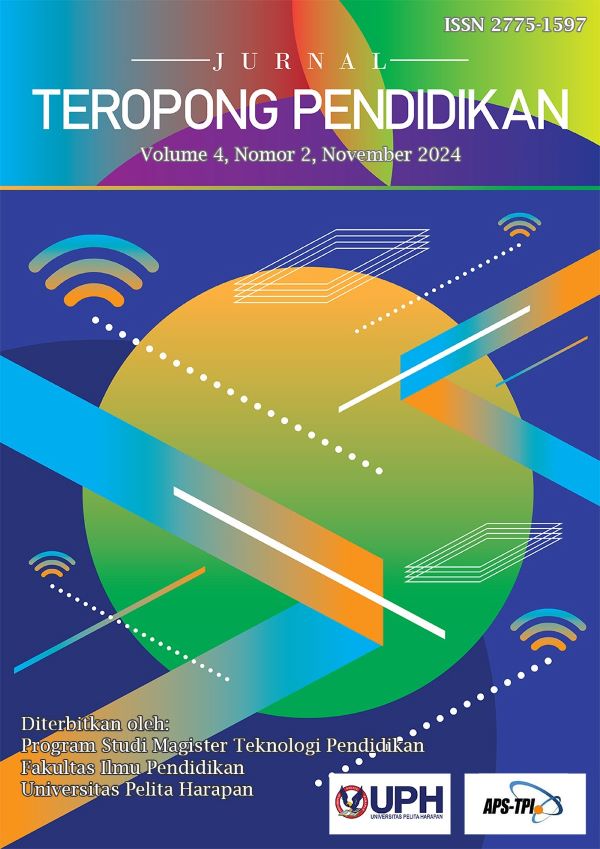Pengaruh Media Pengajaran Dalam Peningkatan Partisipasi Belajar Peserta Didik Pada Proses Belajar Asynchronous Pada Kelas Inklusi [The Influence of Teaching Media on Improving Student Participation in Asynchronous Learning in Inclusive Classes]
DOI:
https://doi.org/10.19166/jtp.v4i2.9036Keywords:
Education, Inclusion, Google Classroom, InteractiveAbstract
Every individual, including students with special needs or those with exceptional intelligence, has the same right to education. Unfortunately, many educators still lack sufficient awareness about this phenomenon. As a result, issues in the classroom related to students with special needs are often not adequately addressed. Therefore, the solution to this challenge is inclusive education. The implementation of inclusive education can help students develop their potential to the fullest. This study aims to provide basic knowledge about inclusive education to graduate students of Universitas Pelita Harapan, class of 52, through interactive learning on Google Classroom. The research uses a qualitative approach, with 18 respondents who are expected to identify early signs if one of their students shows special characteristics. The findings of the study show that the completion rate of tasks in the inclusive classroom did not fully reach 100%, indicating that some participants did not complete their assignments. However, participation in the inclusive classroom remained high, with a minimum task completion rate of 80.3%. The use of interactive and varied learning media can facilitate the development of various types of intelligence in students, creating a more inclusive and empowering learning environment.
References
Amri, M., & Shobri, Y. A. (2020). Persepsi mahasiswa terhadap penggunaan Quizizz dalam pembelajaran Akuntasi Konsolidasi Bank Syariah di IAIN Ponorogo. Jurnal Teknologi Informasi Dan Pendidikan, 13(1), (128–136). https://doi.org/10.24036/tip.v13i1.301
Connolly, T. M., Stansfield, M., & Hainey, T. (2007). An application of games-based learning within software engineering. British Journal of Educational Technology, 38(3), 416–428.
Gardner, H. (2006). Multiple intelligences. Basic Books.
Hart, J. (2018). Top tools for learning. Association for Computing Machinery.
Mardhiyana, D., Setyarum, A., & Fitri, A. (2022). Penggunaan video interaktif edpuzzle dalam pembelajaran matematika dan bahasa pada era merdeka belajar di SMP Al Fusha Kedungwuni. Jurnal Pengabdian Masyarakat, 4(4), 1671–1679. http://dx.doi.org/10.20527/btjpm.v4i4.6139
Prastowo, A. (2012). Panduan kreatif membuat bahan ajar inovatif. Yogyakarta, Indonesia: Diva Press.
Rahmasari, E. A., & Yogananti, A. F. (2021). Kajian usability aplikasi canva: Studi kasus penggunaan mahapeserta didik desain. Jurnal Desain Komunikasi Visual & Multimedia, 7(1), 165–178. https://doi.org/10.33633/andharupa.v7i01.4292
Rahmatullah, R., Inanna, I., & Ampa, A. T. (2020). Media Pembelajaran Audio Visual Berbasis Aplikasi Canva. Jurnal Pendidikan Ekonomi Undiksha, 12(2), 317–327. https://doi.org/10.23887/jjpe.v12i2.30179
Ramadhan, A. (2010). Mengolah audio dan MP3 dengan Audacity. Jakarta, Indonesia: PT. Elex Media Komputindo.
Sundi, V. H., Astari T., Rosiyanti, H., & Ramadhani, A. (2020). Efektivitas penggunaan edpuzzle dalam meningkatkan motivasi belajar pada masa pandemi Covid-19. Seminar Nasional Pengabdian Masyarakat, 1–10. https://jurnal.umj.ac.id/index.php/semnaskat/article/view/8074/4835
Susanto, F., Rahayu, E. M., Hidayat, R., Hertiki., & Nungki, A. (2021). Pemanfaatan moda aplikasi padlet untuk keterampilan membaca dan menulis bagi guru-guru SMA/K Se-Kabupaten Sidoarjo. Jurnal Pendidikan, 1(2), 84–95. https://doi.org/10.36456/kanigara.v1i2.3996
Utari, D. A., Miftachudin., Puspandari, L. E., Erawati, I., & Cahyaningati, D. (2022). Pemanfaatan H5P dalam pengembangan media pembelajaran bahasa online interaktif. Jurnal Pendidikan Bahasa dan Sastra Indonesia, 7(1), 63–69. https://journal.trunojoyo.ac.id/metalingua/article/view/14896/6825
Wecsler, D. (2024). American psychologist. Encyclopedia Britannica. https://www.britannica.com/biography/David-Wechsler-American-psychologist.
Downloads
Published
Issue
Section
License
Copyright (c) 2025 Dinda Nurlia Pratiwi; Prinastining Dyah Wigati; Robinson Leonardo Ticoalu

This work is licensed under a Creative Commons Attribution-ShareAlike 4.0 International License.
Authors who publish with this journal agree to the following terms:
1) Authors retain copyright and grant the journal right of first publication with the work simultaneously licensed under a Creative Commons Attribution License (CC-BY-SA 4.0) that allows others to share the work with an acknowledgement of the work's authorship and initial publication in this journal.
2) Authors are able to enter into separate, additional contractual arrangements for the non-exclusive distribution of the journal's published version of the work (e.g., post it to an institutional repository or publish it in a book), with an acknowledgement of its initial publication in this journal.
3) Authors are permitted and encouraged to post their work online (e.g., in institutional repositories or on their website). The final published PDF should be used and bibliographic details that credit the publication in this journal should be included.





